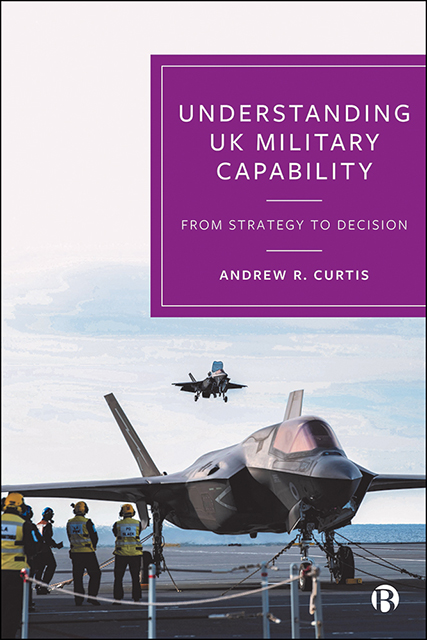Book contents
- Frontmatter
- Contents
- List of Figures and Tables
- List of Abbreviations
- Preface
- 1 Introduction
- 2 Strategic Direction and Military Capability
- 3 The UK’s Approach to Strategy
- 4 Defence Roles, Missions and Tasks
- 5 Defence Reviews
- 6 The Affordability of Defence
- 7 The MoD and the Single Services
- 8 Why Does the UK Have the Military Capability That It Has?
- Notes
- Bibliography
- Index
4 - Defence Roles, Missions and Tasks
Published online by Cambridge University Press: 21 June 2023
- Frontmatter
- Contents
- List of Figures and Tables
- List of Abbreviations
- Preface
- 1 Introduction
- 2 Strategic Direction and Military Capability
- 3 The UK’s Approach to Strategy
- 4 Defence Roles, Missions and Tasks
- 5 Defence Reviews
- 6 The Affordability of Defence
- 7 The MoD and the Single Services
- 8 Why Does the UK Have the Military Capability That It Has?
- Notes
- Bibliography
- Index
Summary
Most studies into post-Second World War UK defence matters spend at least some time examining comparisons between what the armed forces had and currently have in terms of manpower and equipment. Considering the substantial reductions that have occurred during this period, that is unsurprising. As an example, when Duncan Sandys was deliberating on the contraction of the armed forces in 1957, the combined size of the three services was approximately 690,000 (MoD, 1957, p 7). The start point for the 2021 IR was a full-time trained strength of 135,444 (Dempsey, 2021, p 5). For a statistic closer to home, when I left regular service in 2019, the RAF had an active fast jet fleet of 121 aircraft (GOV.UK, 2020e). When I joined 35 years earlier, it had more fighters and bombers than that just based in Lincolnshire (Mason, 1982, pp 142–3). Of course, no-one is suggesting the English Electric Lightning, which was the RAF’s first supersonic jet fighter and entered service in 1960 (1982, p 13), is comparable to its namesake, the RAF’s newest and most advanced fast jet the Lockheed Martin Lightning II. Nevertheless, since the 1957 defence review, the UK’s armed forces have seen a regular decline in personnel and equipment numbers. From the end of the Cold War percentage reductions in front-line strength have been more substantial. However, as Keith Hartley (2011, p 12) observed, the published data do not allow any assessment of these smaller forces and the impact on aggregate defence capability.
The defence budget is used to procure and maintain military capability through expenditure on each of the MoD’s eight DLODs. Clearly some of these, for example equipment, personnel and infrastructure, attract more cost than others, such as doctrine and concepts and organization. The DLODs are the inputs that enable Defence’s outputs; however, pinning down exactly what Defence’s outputs are is no easy task. Hartley (2011, p 11) suggested that UK defence output is a multi-dimensional concept embracing the protection of the nation’s citizens and their assets, its economy and economic infrastructure, its national institutions and its national interests.
- Type
- Chapter
- Information
- Understanding UK Military CapabilityFrom Strategy to Decision, pp. 66 - 96Publisher: Bristol University PressPrint publication year: 2022



